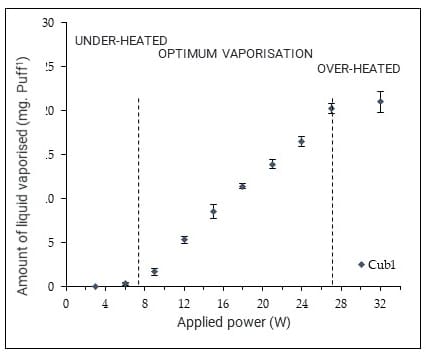0,5 Ω = 0,5 Ω?
In a personnel vaporiser, the design of an atomiser makes it unique. It has a range of optimum power in which the more energy is provided, the greater will be the amount of liquid vaporised. This range is called the optimum vaporisation regimen and is different for each atomiser.
The variety of models of electronic cigarettes commercially available is considerable. Two types of equipment with the same value of resistance and the same power applied produce different sensations of inhalation perceived by a consumer. Even for the same liquid. To explain this phenomenon, a first element of response was recently given in an article [1]. The question then is to know if these two devices generate the same amounts of vapour?
Optimum vaporisation regimen
Vaporisation performance consists in varying the power of a device and in characterising the amount of liquid vaporised. If this is zero, the performance is said to be under-regimen. If it increases with the power linearly, the performance is called optimum vaporisation regimen. Above a certain power value, over-regimen is reached and the amount of liquid vaporised decreases. These three regimens are linked to three different levels of energy performance.
The first illustrates insufficient energy supplied to achieve liquid vaporisation. The second highlights an ideal regimen where the more that energy is delivered, the more liquid will be absorbed to be vaporised. The last conveys too much energy which in general leads to deteriorate the cotton and to a dry-puff. They are well illustrated for the reference atomiser used in the ingésciences laboratory: Cubis. For 12 other atomisers tested, only the optimum regimen is observed and then characterised. Each atomiser has specific characteristics. The range of linearity and its slope are different from one device to another. This explains, for example why two atomisers of 0.5 Ω used at the same power of 50 W do not have the same amounts of liquids vaporised. The physical characteristics of the atomisers used are then taken into account to further the study (area of resistance wire, type of metal used, etc.). These are not always given by the supplier and more thorough measurements are difficult to perform.

2.6% repeatability
The repeatability of puffs via the device, is also a key element for assessing the amount of vapour generated. In the case of Cubis, more than 440 puffs were generated successively. Between a full reservoir and an empty one, the amount of liquid vaporised per puff did not vary by more than 2.6%. For the 12 other devices tested out of 100 puffs[2], 9 had a deviation less than 5%. The 3 others are below 15%. This repeatability acts on the perception of the consumer who could get different sensations from puff to another. This can be all the more accentuated if one adds the stability of the batteries[3]. Discharge of the battery will lead to a natural reduction of the power actually applied and thus the amount of liquid vaporised.
[1] Soulet, S.; Duquesne, M.; Toutain, J.; Pairaud, C.; Lalo, H. Influence of Coil Power Ranges on the E-Liquid Consumption in Vaping Devices. Int. J. Environ. Res. Public Health 2018, 15, 1853.
[2] AFNOR XP D90-300-3 – Cigarettes électroniques et e-liquides – Partie 3 : exigences et méthodes d’essais relatives aux émissions.
[3] Soulet, S.; Pairaud, C.; Lalo, H. A Novel Vaping Machine Dedicated to Fully Controlling the Generation of E-Cigarette Emissions. Int. J. Environ. Res. Public Health 2017, 14, 1225.









No comment
Be the first to leave a comment